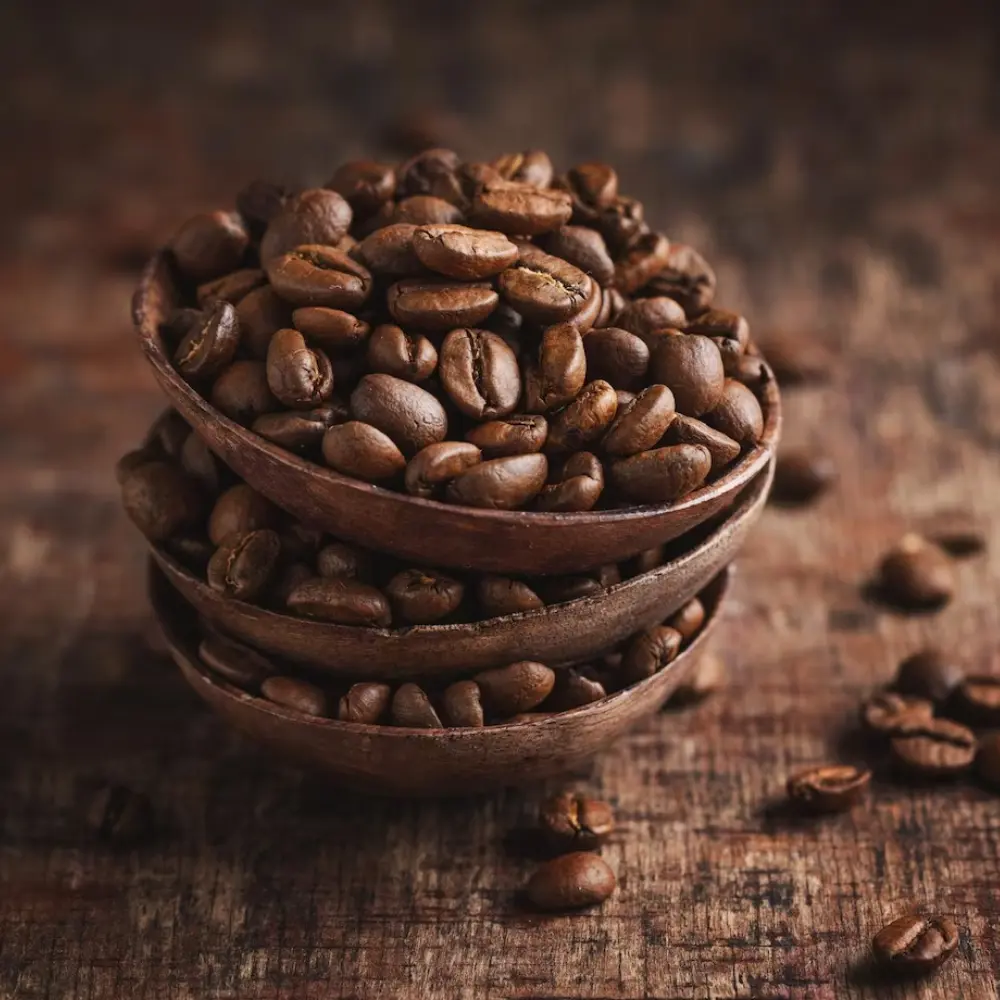Coffee is an elixir that transcends cultures and borders, but nowhere is it more deeply woven into the fabric of everyday life than in the Middle East. Central to this rich tradition is the dallah, an ornate coffee pot symbolizing hospitality and respect. Welcome to our comprehensive exploration of “The Art and Significance of the Dallah Coffee Pot.”
Stepping into a Middle Eastern home, the aroma of rich, strong Arabic coffee, or “gahwa,” fills the air. This isn’t your standard cup of joe—it’s a labor of love, a symbol of community, and a gift of goodwill. Brewed in the heart of a home, gahwa is prepared in a dallah, an iconic pot uniquely designed to extract the perfect blend of flavors from the coffee and spices.
In this in-depth guide, we dive deep into the artistry of the dallah, the intricate details of its design, and its indispensable role in the preparation of Arabic coffee. Join us as we unravel the heritage, customs, and etiquette tied to this emblem of Middle Eastern hospitality. Whether you’re a coffee connoisseur or a curious reader, there’s something in the story of the dallah that is sure to captivate you.
Dallah Coffee Pot: Key Takeaway
- Rich Historical Roots: The dallah coffee pot has a rich history in Middle Eastern culture, originating as a functional item but evolving to become a significant cultural symbol and an art form in itself.
- Tradition in a Cup: Brewing Arabic coffee or gahwa in a dallah is a cherished tradition. It’s not just about making a beverage; it’s a ritual that fosters community bonds and preserves a sense of cultural identity.
- Symbol of Cultural Identity: Beyond its functional use, the dallah is revered as a cultural icon and artistic motif. It’s featured prominently in Middle Eastern art, media, and even on currency, symbolizing hospitality, community, and the region’s rich coffee tradition.
- Timeless Relevance: The dallah’s relevance extends to modern times, with the coffee pot being a prized collectible, a staple in contemporary Middle Eastern homes, and a symbol of cultural heritage.
- Investing in Heritage: Buying a dallah is an investment in a piece of cultural heritage. When purchasing a dallah, it’s important to verify its authenticity, understand the price range, and know how to maintain and clean it to preserve its beauty and functionality.
The Rich History of the Dallah
The dallah, with its rich heritage, is more than just a coffee pot. It’s a piece of art that encapsulates centuries of tradition and community, mirroring the evolution of the societies that created it. To appreciate the full scope of its significance, we must delve into its intriguing history.
Origins of the Dallah Coffee Pot
The dallah traces its roots back to the Bedouin nomads of the Arabian Peninsula. Over a thousand years ago, these desert wanderers discovered a new kind of energizing brew made from the beans of the Coffea plant. With its stimulating effects and robust flavor, coffee quickly became an integral part of their daily life. To prepare it, they needed a special kind of vessel that could withstand the heat of the desert sand, which they used to boil water. Thus, the dallah was born. (1)
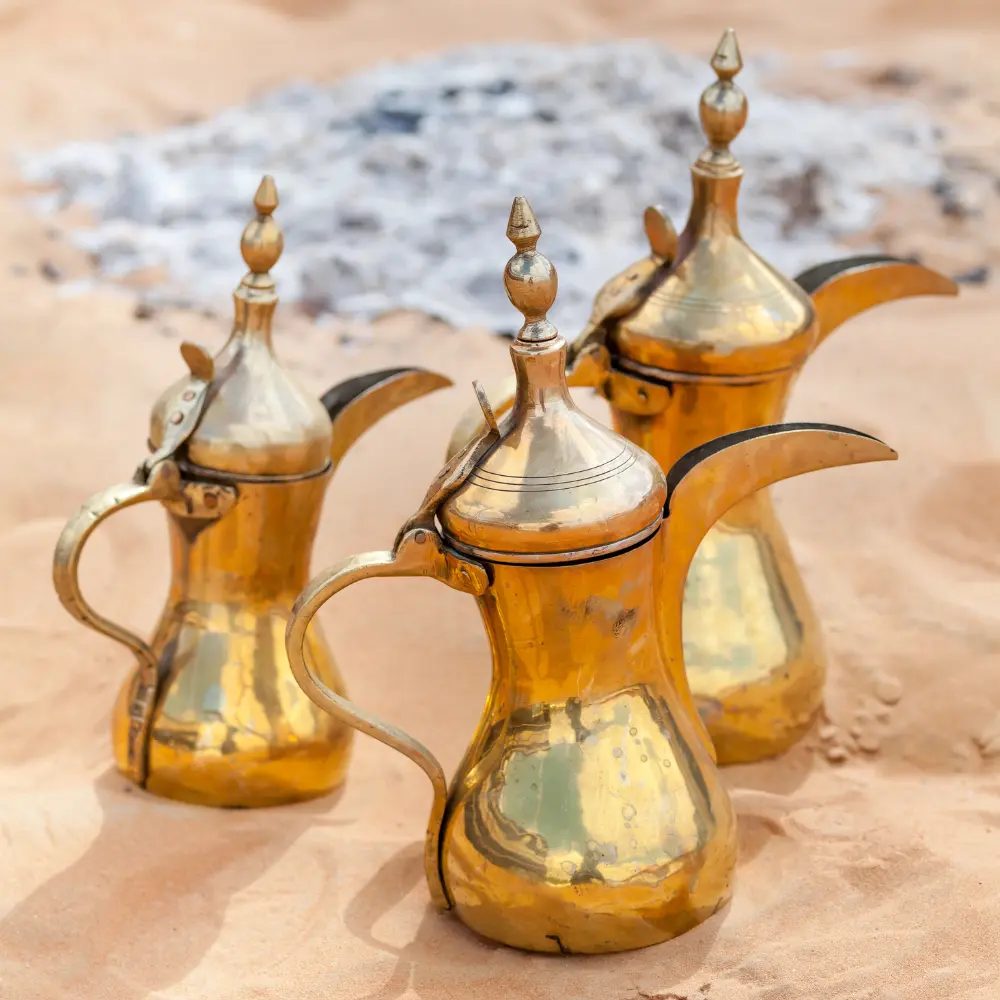
Constructed from metals like brass and copper, the dallah featured a large, bulbous base and a long, slender spout, with a distinctive lid often topped with a bird or a crescent—an homage to the Islamic culture prevalent in the region. These nomadic tribes believed in the virtue of hospitality, and sharing coffee brewed in the dallah became a sacred ritual to welcome guests and forge bonds.
Evolution of Dallah Design Over the Centuries
Over the centuries, the design of the dallah has evolved, reflecting the changing times and tastes. The basic shape has remained the same, but the artistic elements have become increasingly intricate. With the rise of the Ottoman Empire and the spread of Islam, more ornate dallahs began to appear, featuring elaborate carvings and inscriptions, often verses from the Quran or well-wishing phrases.
The Dallah as a Symbol of Middle Eastern Culture
Today, the dallah holds a place of honor in Middle Eastern culture. It is more than just a utilitarian object; it is a symbol of Arabian identity and heritage. The act of brewing gahwa in a dallah and serving it to guests is steeped in symbolism and ritual. The process is methodical and slow, allowing for conversation and connection—a reflection of the region’s emphasis on community and hospitality.
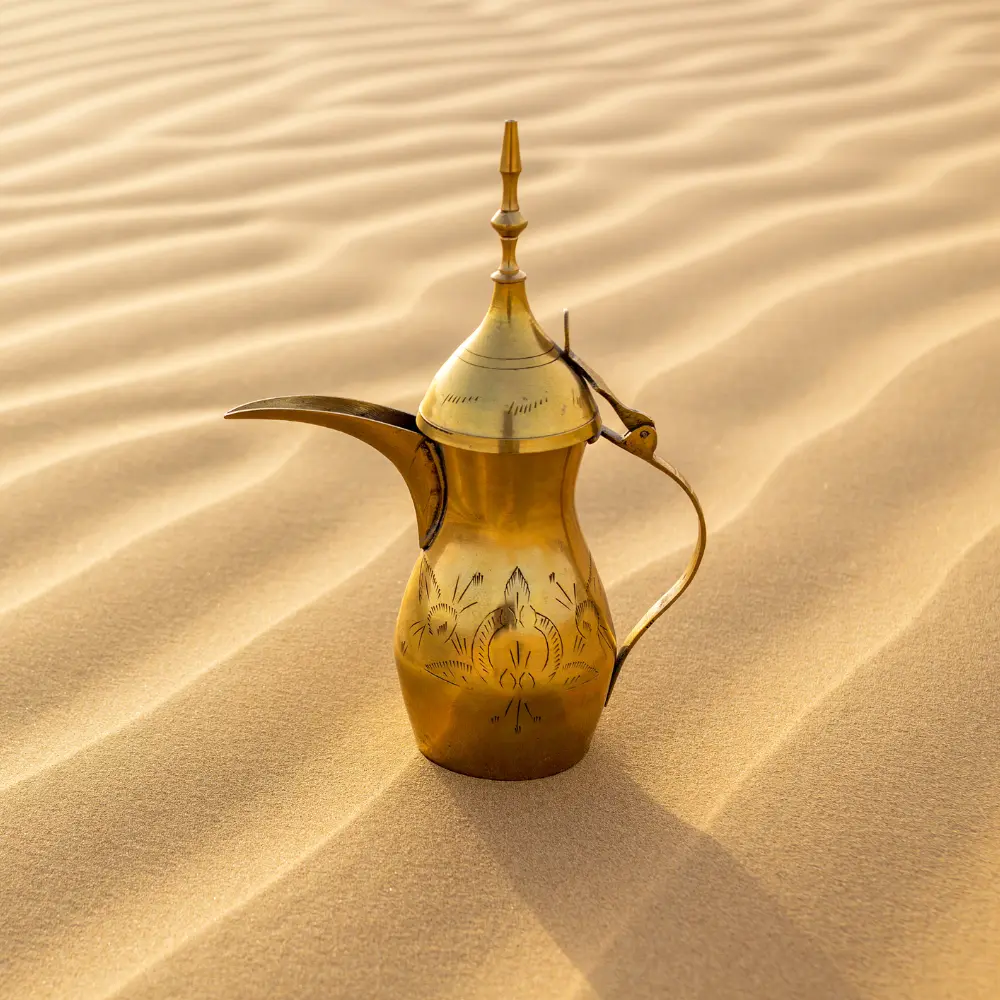
Furthermore, the dallah has found its way into art, literature, and even currency, with a dallah prominently featured on the United Arab Emirates one-dirham coin. Whether it’s a high-end dallah artfully crafted from silver or a simple brass pot used in a Bedouin tent, the dallah remains an enduring symbol of Middle Eastern culture, hospitality, and the region’s love for coffee.
The Art and Craftsmanship of Dallah Making
Creating a dallah coffee pot is a meticulous process that requires skill, patience, and a deep understanding of tradition. From the selection of materials to the intricate designs that adorn each pot, each step in dallah production is a testament to the craftspeople’s dedication and the rich cultural heritage they uphold.
The Traditional Materials Used in Dallah Production
The choice of materials in the construction of a dallah is critical, not just for its functionality, but also for its aesthetic appeal. Traditionally, dallahs were made from brass or copper—metals known for their durability and heat conductivity, essential for brewing the perfect cup of coffee.
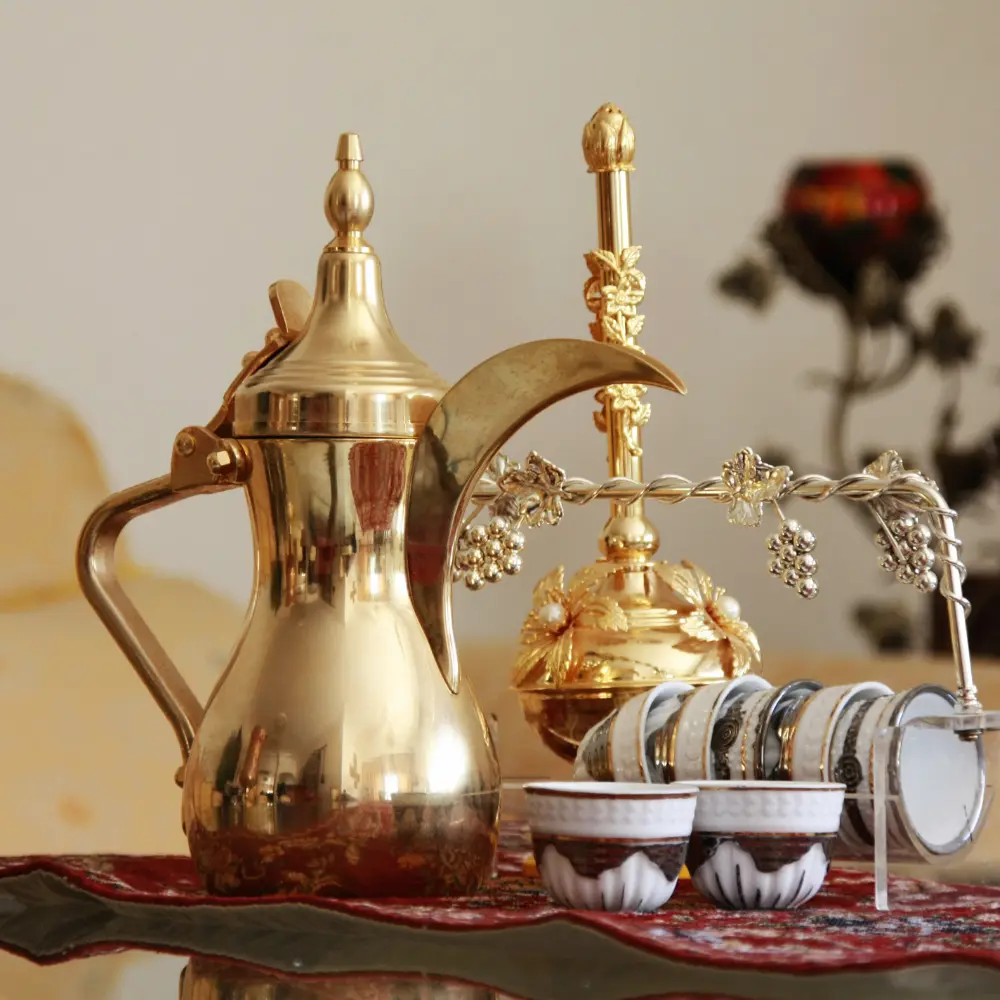
Over time, as the dallah evolved from a utilitarian item to a more decorative one, other materials like silver and gold were introduced. These precious metals elevated the status of the dallah, transforming it into a treasured item of luxury and prestige. Despite these changes, the functional design of the dallah coffee pot has remained consistent, ensuring it continues to fulfill its original purpose of brewing coffee.
The Artistry and Skill of Dallah Craftspeople
The creation of a dallah coffee pot is a testament to the artistry and skill of the craftspeople. Each dallah is handcrafted, often by artisans who have inherited the craft through generations. These artisans employ traditional techniques, such as hammering the metal into shape and carefully etching intricate designs onto the surface.
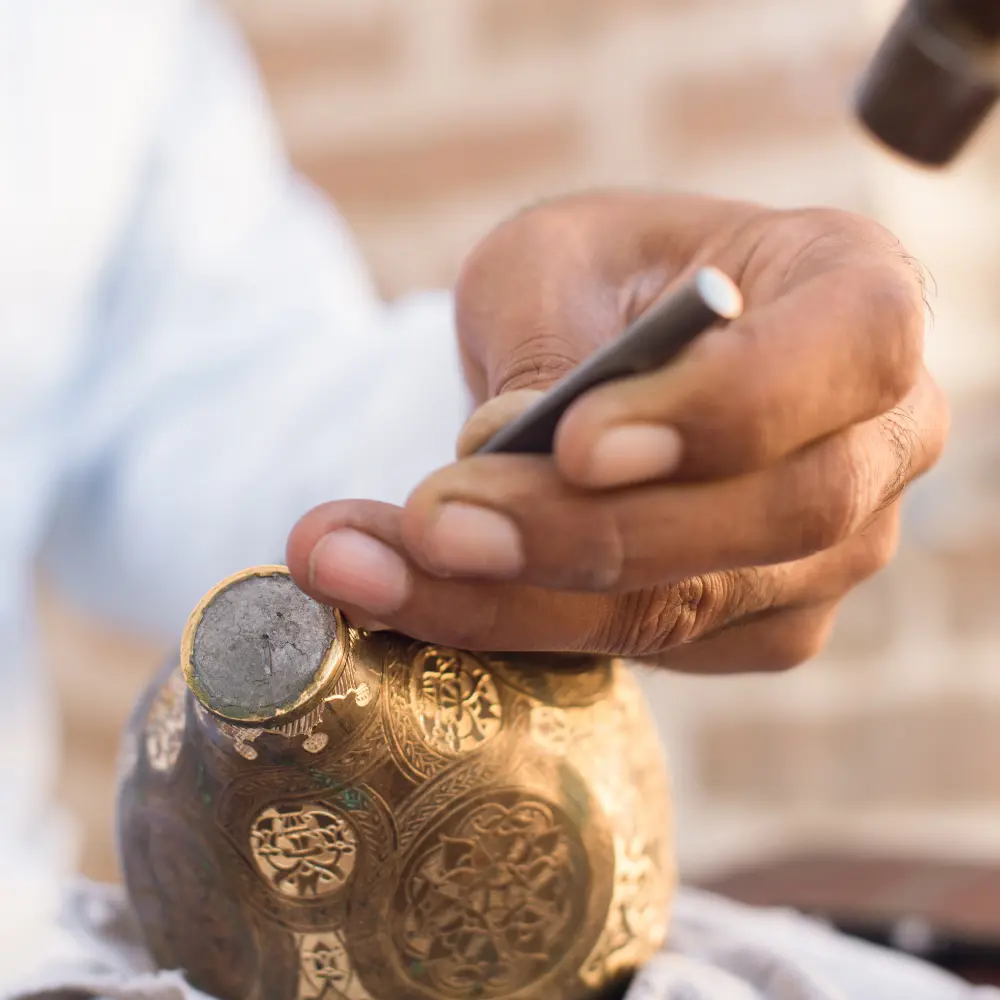
The process is labor-intensive and time-consuming, but the result is a unique piece of art. The craftsmen pour their heart and soul into each dallah, with the fine details and distinctive motifs reflecting the creator’s style and the cultural heritage of the region.
Notable Dallah Design Variations and Their Meanings
While the basic structure of the dallah coffee pot remains the same—a large body, a long spout, and a distinctive lid—the designs and motifs that adorn it can vary significantly. These designs often carry symbolic meanings and reflect the cultural identity of the region where they were created.

For instance, dallahs from Saudi Arabia often feature palm tree and coffee plant motifs, symbolizing the country’s lush oases and rich coffee culture. Those from Qatar frequently display geometric patterns, a nod to Islamic art and architecture. A dallah from Oman might showcase designs inspired by the country’s diverse flora and fauna.
These variations in design not only add to the aesthetic value of the dallah but also tell a story about the people and the culture that created them. Whether it’s a simple, unadorned brass pot or an ornate silver dallah, each piece is a tangible link to the rich history and cultural heritage of the Middle East.
Brewing Coffee in a Dallah: A Step-by-Step Guide
Brewing Arabic coffee, or gahwa, in a dallah coffee pot is an art that requires the right ingredients, a bit of skill, and plenty of patience. The result is a rich, aromatic coffee that is unlike anything you might have tasted before. Below, we provide a step-by-step guide to help you master this process.
Choosing the Right Coffee and Spices
The first step to brewing the perfect gahwa is to select the right coffee and spices. Arabic coffee is typically made from lightly roasted beans, which give it its distinctive color and flavor. The beans are then ground into a fine powder.

As for spices, cardamom is a must. This aromatic spice is a staple in Arabic coffee, adding a unique, slightly spicy flavor. Some people also choose to add other spices like saffron, for a bit of luxury and sweetness, or cloves and cinnamon for a warming note.
The Process of Brewing Coffee in a Dallah

Now, let’s get to the heart of the process: brewing the coffee in the dallah coffee pot.
- Fill the dallah with water. The amount of water will depend on the number of servings you want to make, but a general rule of thumb is to use 3 cups of water for every 1 cup of coffee grounds.
- Place the dallah on the stove and bring the water to a boil.
- Once the water is boiling, add the coffee grounds and reduce the heat to low. Let it simmer for about 15-20 minutes. This slow brewing process is key to extracting all the flavors from the coffee.
- Add the cardamom and any other spices you’re using, and let it simmer for another 10-15 minutes. The longer you simmer it, the stronger the flavor will be.
- Remove the dallah from the heat and let it sit for a couple of minutes to allow the coffee grounds to settle at the bottom.
Serving Coffee from a Dallah: Etiquette and Tips

Serving coffee from a dallah is not just about pouring a drink; it’s a ritual steeped in tradition and etiquette.
- Gahwa should always be served in small, handle-less cups, filling only one-third of the cup. This is because the coffee is quite strong and also to ensure it stays hot for the guest.
- Always serve the coffee with your right hand, a sign of respect in Arab cultures.
- Begin by serving the eldest in the group or the guest of honor to show respect.
- It’s customary to serve dates or other sweet treats with the coffee to balance the bitterness of the gahwa.
Remember, the key to a great cup of gahwa is patience. Don’t rush the brewing process, and take the time to enjoy the rich aroma and flavor of the coffee. After all, drinking Arabic coffee is about more than just caffeine—it’s about experiencing a centuries-old tradition and a unique aspect of Middle Eastern culture.
The Significance of the Dallah in Modern Times
The dallah may be an artifact with ancient roots, but its relevance has not waned in modern times. In fact, it has carved out an enduring place for itself in contemporary Middle Eastern homes, culture, and even the world of art and collectibles. Whether it’s brewing a pot of aromatic gahwa coffee, serving as an icon of cultural identity, or standing as a prized collectible, the dallah continues to hold a significant place in the 21st century.
The Dallah in Contemporary Middle Eastern Homes
Despite the advent of modern coffee makers and brewing techniques, the dallah remains a fixture in many Middle Eastern homes. The ritual of brewing Arabic coffee in a dallah, serving it to guests, and savoring it together, is a cherished tradition. It’s an opportunity to slow down, engage in meaningful conversation, and strengthen community bonds.
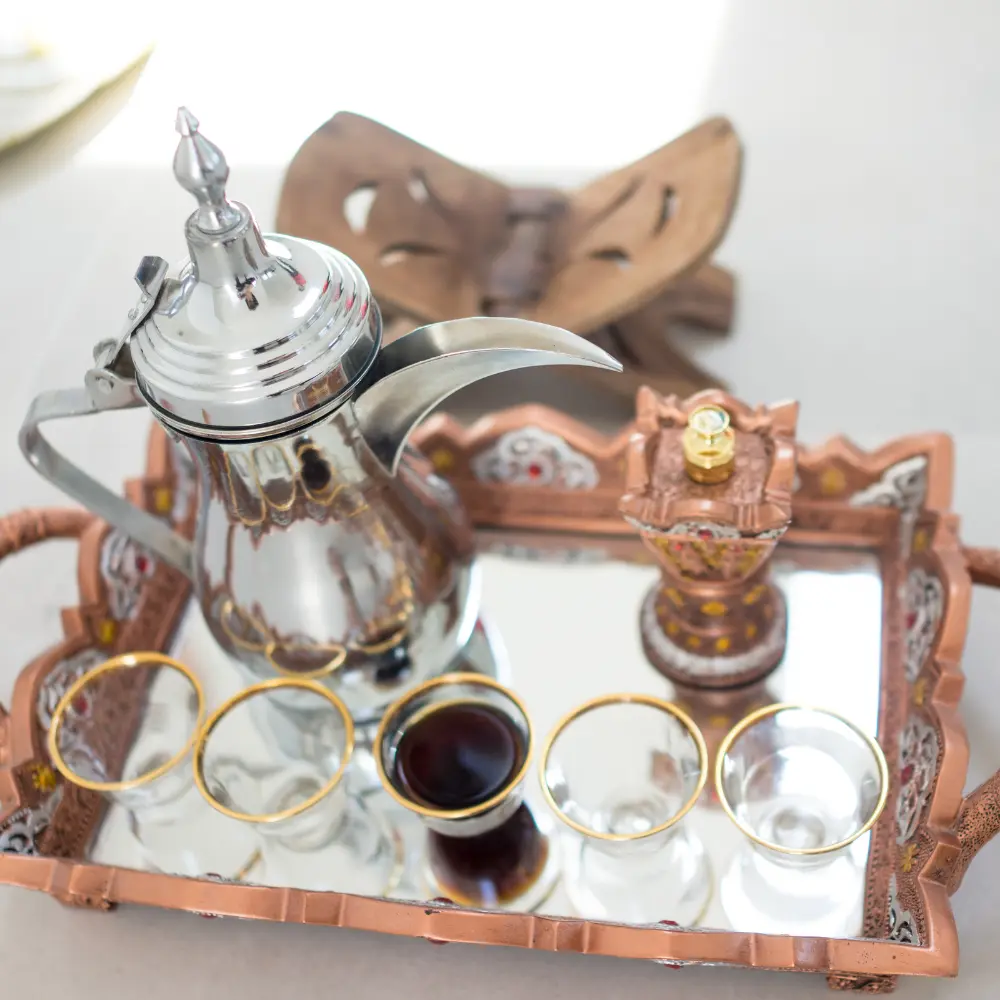
Moreover, a beautifully crafted dallah is often displayed as a piece of decor, a testament to the homeowner’s appreciation of their cultural heritage. The dallah is a bridge between the past and the present, a symbol of a proud history that continues to be celebrated.
The Dallah as a Cultural Icon and Artistic Motif
Beyond its practical use, the dallah has emerged as a powerful cultural icon and artistic motif. As discussed earlier, it’s prominently featured in Middle Eastern art, literature, and media, symbolizing hospitality, community, and the region’s rich coffee tradition.
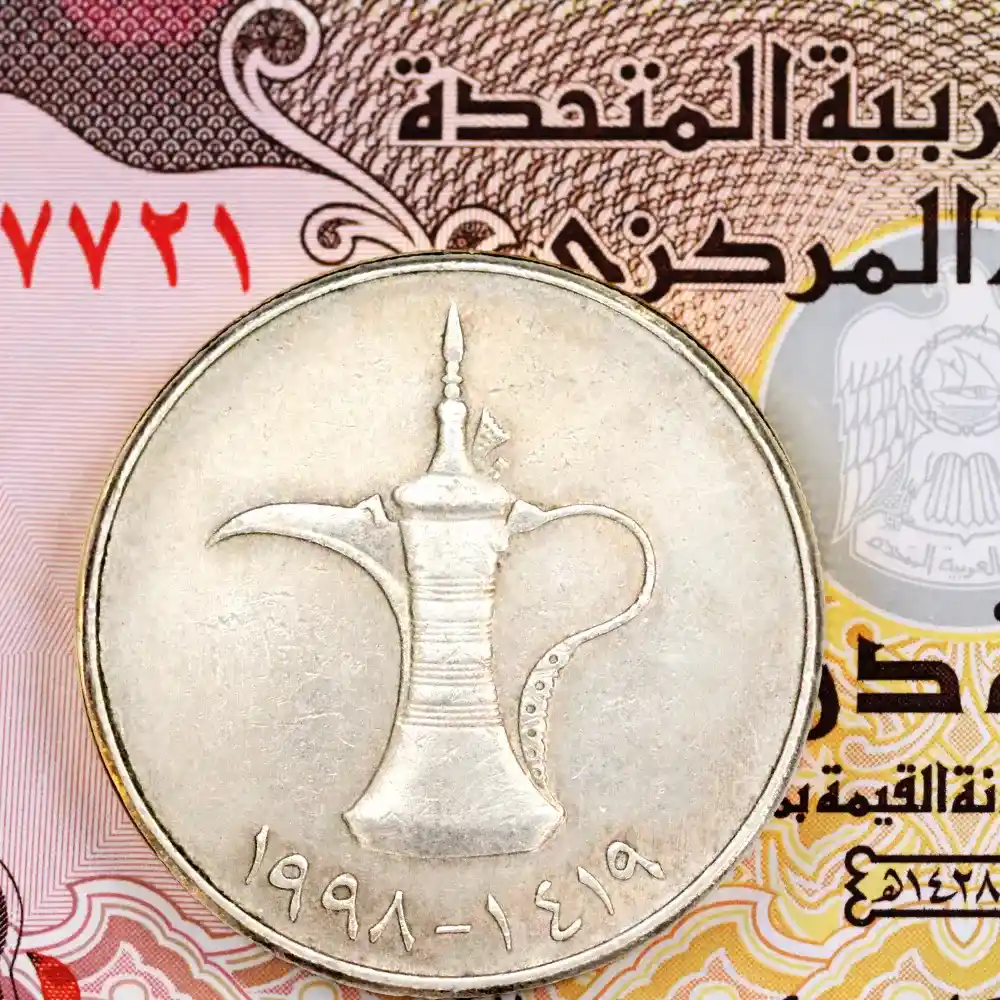
You can find the dallah in a wide range of artistic and cultural expressions, from paintings, sculptures, and jewelry designs, to logos, stamps, and even on the UAE’s one dirham coin. Its distinctive shape and the cultural significance it carries make the dallah an enduring symbol of Middle Eastern heritage.
Preserving and Collecting Dallahs
The dallah has also found its way into the world of collectors and historians. Antique dallahs, with their intricate designs and patina of age, are sought-after collectibles. Each one tells a story of the era and the region it comes from, making it a tangible piece of history.

Museums, too, recognize the dallah’s cultural value. The Dallah Museum in Qatar, for instance, has an extensive collection of dallahs from different periods and regions, preserving and showcasing the evolution of this iconic coffee pot.
To sum up, the dallah’s significance extends far beyond its role as a coffee pot. In a world that’s increasingly fast-paced, the dallah—whether it’s being used to brew gahwa coffee, displayed as an emblem of cultural identity, or preserved as a valuable artifact—serves as a beautiful reminder of the timeless values of hospitality, community, and a shared history.
Buying a Dallah Coffee Pot: Things to Consider
A dallah coffee pot makes a beautiful addition to your home or a thoughtful gift for someone special. Whether you plan to use it for brewing Arabic coffee or as a decorative piece, buying a dallah is an investment in a piece of cultural heritage. Here are some important things to consider to ensure you choose the right one.
Identifying Authentic Dallahs
Authenticity is key when buying a dallah. An authentic dallah is traditionally handcrafted, with attention to detail and craftsmanship evident in its design. Look for signs of handiwork, such as hammer marks or slight asymmetry in the design—these are indicators that the dallah has been hand-shaped rather than machine-made.
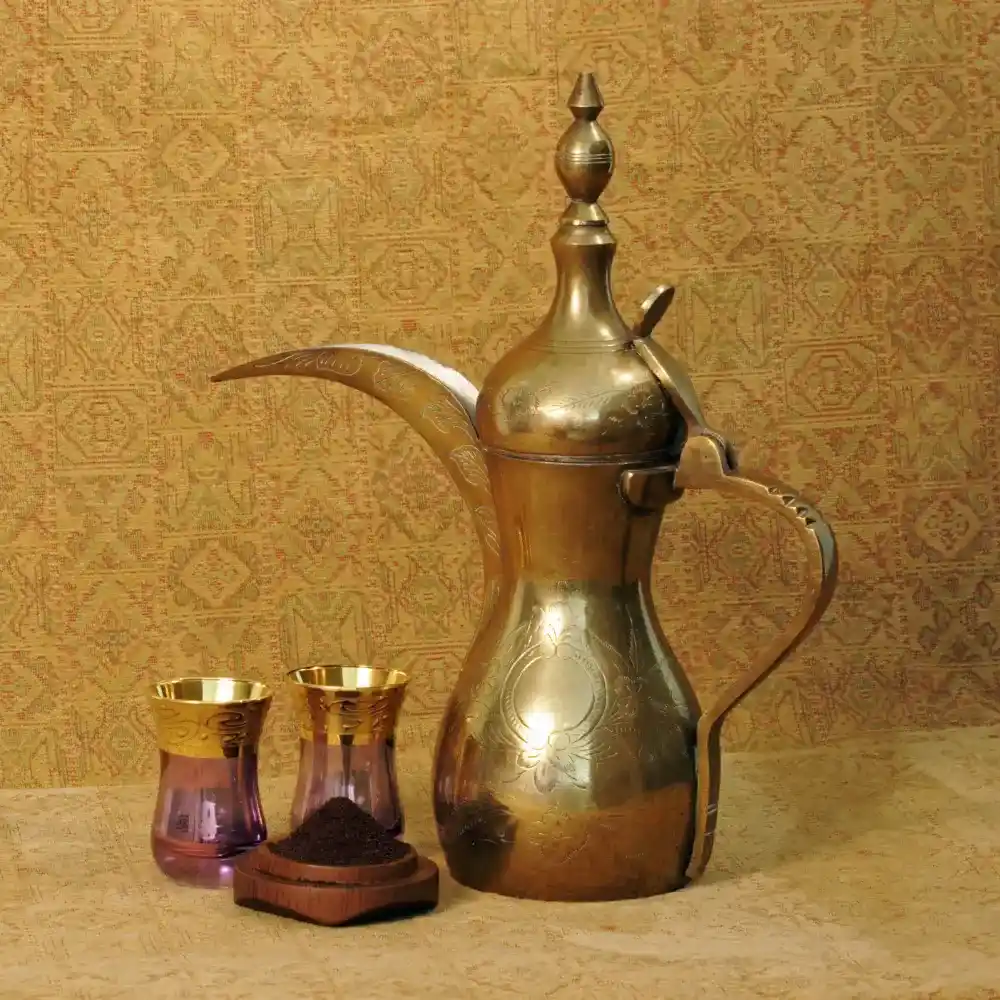
The material of the dallah can also be a clue to its authenticity. Traditional dallahs are made from brass or copper, though silver and gold dallahs are also available. Check for any hallmark or maker’s mark—these are often found on the bottom or the side of the pot and can provide information about the origin and the maker of the dallah.
Price Ranges and Where to Buy
The price of a dallah can vary greatly, depending on factors like its age, material, the intricacy of the design, and the reputation of the artisan. Basic, new dallahs can be found for as little as $20, while antique or intricately designed dallahs can command prices in the hundreds or even thousands of dollars.
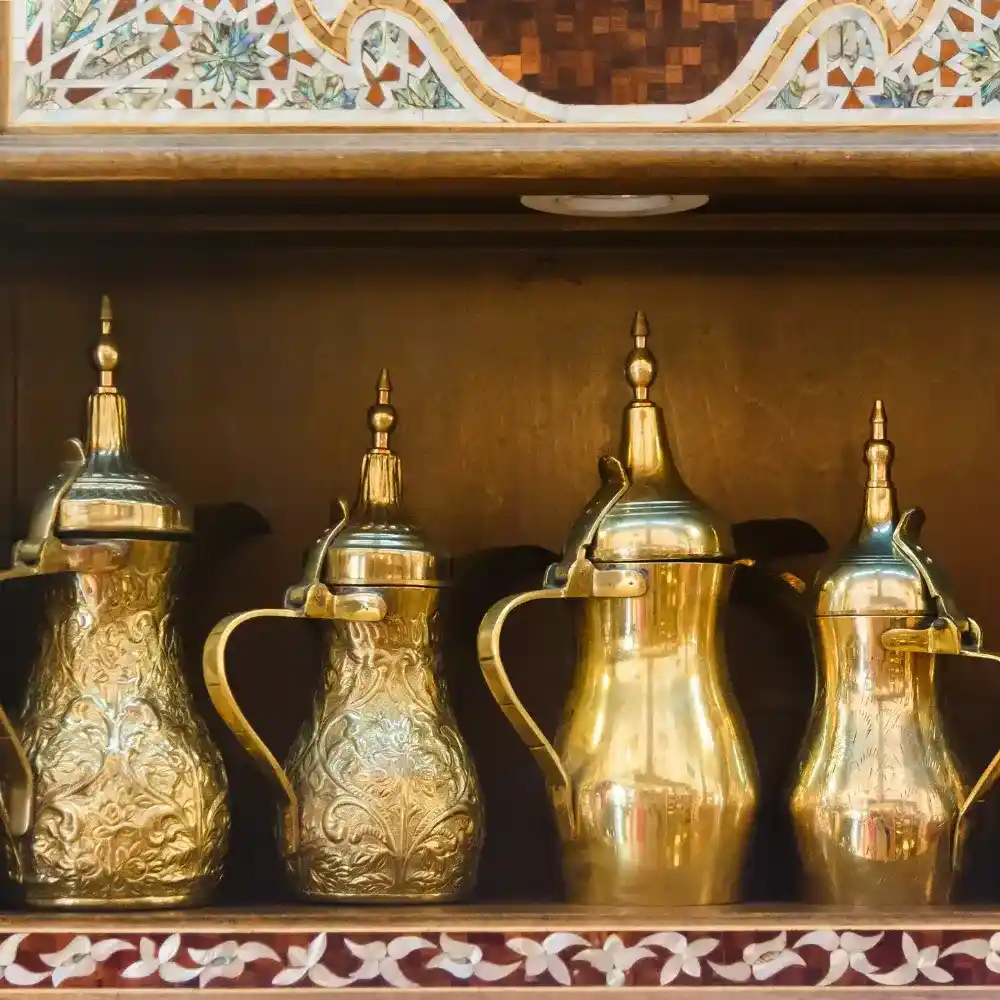
Dallahs can be purchased from a variety of places. Souks and markets in the Middle East are traditional sources, offering a wide range of options. In recent years, online platforms have also become popular for buying dallahs, providing access to a global market. However, when buying online, it’s particularly important to ensure the authenticity and quality of the dallah.
Caring for Your Dallah Coffee Pot: Maintenance and Cleaning
Proper care and maintenance are essential to keep your dallah looking its best and functioning properly. Here are some tips:
- Clean your dallah after each use. Rinse it with warm water and avoid using harsh detergents, which can damage the material.
- To remove coffee stains or tarnish, use a gentle cleaning solution made of brass or copper. A homemade paste of lemon juice and baking soda can also be effective.
- After cleaning, dry the dallah thoroughly to prevent water spots and tarnishing.
- When not in use, store your dallah in a dry, cool place to avoid damage from humidity and heat.
Remember, whether you’re buying a dallah for brewing delicious Arabic coffee or as a symbol of cultural heritage, it’s important to choose carefully and take good care of your investment. A well-chosen, well-cared-for dallah can bring joy and beauty for years to come.
This Brass Coffee Arabic Pot made of brass. Have Beautiful engraved design on the outer surface with glossy finish.
About Item:- Size of the item is 8 Inches Height, 6 Inches Width. Weight 375 Gram Approx.
This Arabic Pot made of Pure Brass Metal, Having engraved design with glossy finished.
As Gift Like, marriage party, family friend and neighbor, Christmas, Easter, New Year and thank Giving Gift, Diwali, Eid, Holi, Birthday.
NOTE: Because it is handmade product so, Size can be vary by 1-2 cm. Color of the item can be slightly different from the image.
Conclusion
In conclusion, the dallah coffee pot is more than just a vessel for brewing Arabic coffee or gahwa. It is a symbol of the rich cultural heritage of the Middle East, an embodiment of hospitality, and a timeless piece of functional art. Each dallah, whether it’s being used to brew a pot of aromatic gahwa, serving as a decorative item in a contemporary home, or sitting in a museum collection, has a story to tell. It speaks of a centuries-old tradition, the skill and artistry of its maker, and the warmth of the community where it’s used.
As we navigate our fast-paced modern lives, the dallah serves as a beautiful reminder of the importance of slowing down, savoring the moment, and appreciating the rich traditions that connect us to our past. Whether you’re a coffee enthusiast, a lover of history and culture, or someone who appreciates fine craftsmanship, the dallah has something to offer. We hope this in-depth guide has provided valuable insights into the art and significance of the dallah coffee pot and perhaps even inspired you to experience the tradition of Arabic coffee brewing for yourself.
Remember, brewing and serving coffee from a dallah is an act steeped in tradition and meaning. So, the next time you sip a cup of gahwa, think of the history and culture that it represents. Enjoy not just the rich, aromatic flavor of the coffee, but also the sense of connection to a vibrant cultural heritage.
FAQ
How is coffee traditionally prepared in a dallah?
Coffee is prepared in a dallah by adding coffee grounds and spices to water, bringing it to a boil, and then allowing it to steep. The coffee is then carefully poured from the dallah into small cups, often without handles, called finjan.
Where can I buy an authentic dallah coffee pot?
Authentic dallah coffee pots can be purchased from souks and markets in the Middle East or from reputable online platforms that specialize in Middle Eastern crafts and antiques.
How do I care for and clean my dallah coffee pot?
To care for your dallah, clean it after each use with warm water and avoid harsh detergents. For stubborn stains or tarnish, use a gentle cleaning solution for brass or copper. Always dry your dallah thoroughly after cleaning.
Why is the dallah still used in modern times?
Despite modern coffee-making methods, the dallah is still used today for its ability to brew a unique cup of Arabic coffee. Additionally, it serves as a decorative piece in homes and a symbol of cultural heritage, reflecting a deep sense of history and identity.





